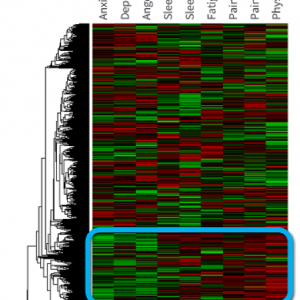
CHOIR incorporates classic testing-theory-based measures, such as the Pain Catastrophizing Scale, and item-response-theory based measures, such as the NIH Patient-Reported Outcomes Measurement Information System (PROMIS). PROMIS measures are normed and validated for the US population, providing a comparative metric across groups, and administered via computer adaptive testing (CAT). Outside the US, the PROMIS International initiative disseminates PROMIS domains worldwide via translation/cultural adaptation, calibration, and validation. CHOIR is flexible, in that each institution can tailor patient-reported-outcome measures to the site, clinic, and condition(s).
By enabling the standardization and large-scale capturing of high-dimensional biopsychosocial data, CHOIR enables users to see what kinds of subsets of patients exist, and to ask research questions about these groups. For instance, the below chart shows that there is a subpopulation of patients with high pain interference, high pain behavior, and high physical function impairment, yet low mood disturbances. Is there something unique about this set of patients? These are the kinds of questions CHOIR allows us to ask and answer.

